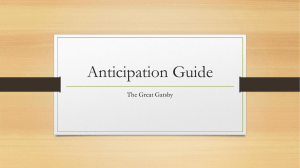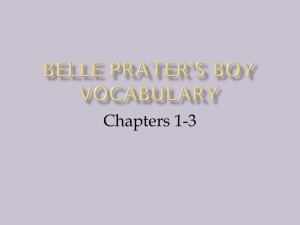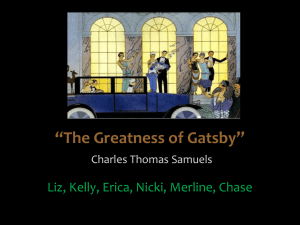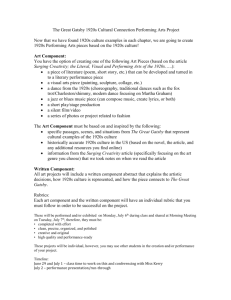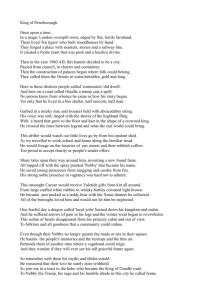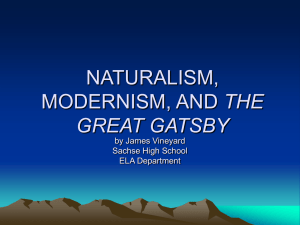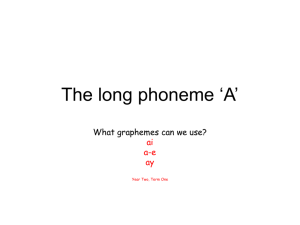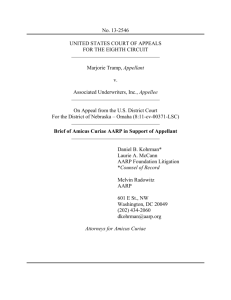Chapter 13 The Roaring Life of the 1920s
advertisement
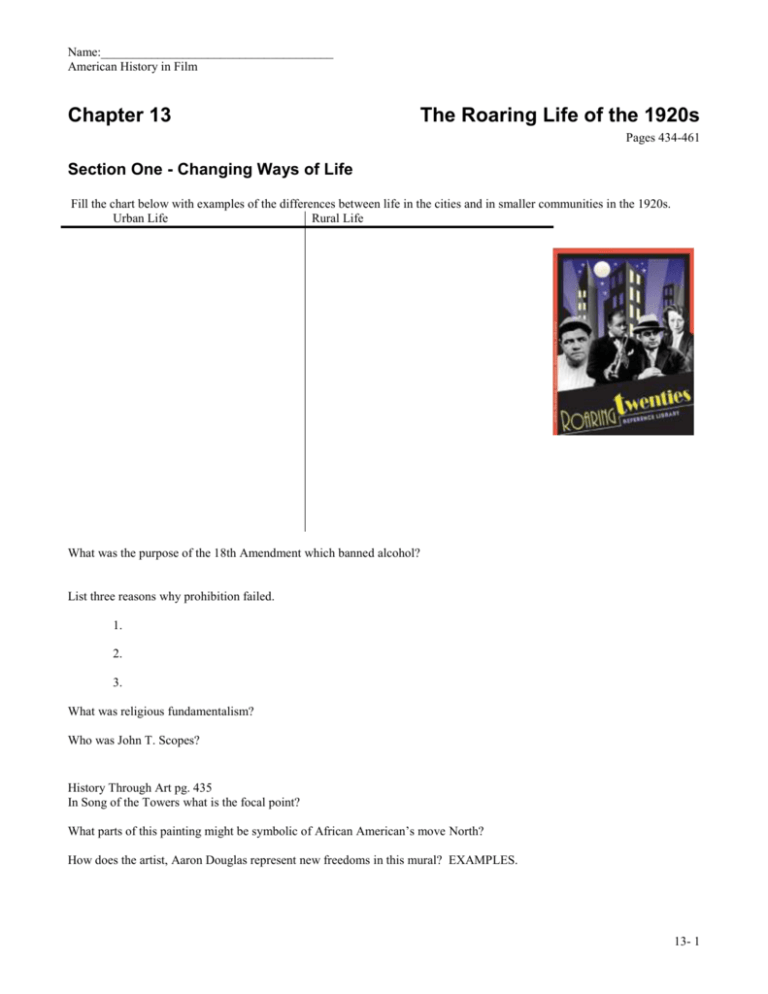
Name:_____________________________________ American History in Film Chapter 13 The Roaring Life of the 1920s Pages 434-461 Section One - Changing Ways of Life Fill the chart below with examples of the differences between life in the cities and in smaller communities in the 1920s. Urban Life Rural Life What was the purpose of the 18th Amendment which banned alcohol? List three reasons why prohibition failed. 1. 2. 3. What was religious fundamentalism? Who was John T. Scopes? History Through Art pg. 435 In Song of the Towers what is the focal point? What parts of this painting might be symbolic of African American’s move North? How does the artist, Aaron Douglas represent new freedoms in this mural? EXAMPLES. 13- 1 What did fundamentalists believe about the biblical account of creation? How did this differ from the view of many liberal thinkers? What main issue did the Scope trial address? Terms & People to Know Billy Sunday Aaron Douglas 18th Amendment Prohibition Speakeasy Bootlegger “organized crime” Al Capone Fundamentalism Clarence Darrow Scopes Trial William Jennings Bryan John Scopes The 20s Woman Section Two - The Twenties Woman What is a flapper? In what three ways did the 1920s woman challenge the social norms of behavior? 1. 2. 3. How did women change the work world? How was the family affected with the changing roles of women? Answer the following questions using the chart on pg. 442 Which type of jobs showed the greatest growth between 1910 and 1930? The greatest decline? What percentage of women held clerical jobs in 1930? About how many times greater was this than the percentage in 1910? During the 1920, a double standard required women to observe stricter codes of behavior than men. Do you think that some women of this decade made real progress towards equality? Give EXAMPLES. 13- 2 Section Three - Education and Popular Culture Youth in the 20s Pg 444-445 What was . . . Flagpole sitting Bobbed hair Dance Fads Gentleman’s Fashions Fill in the chart below by describing the headings Schools Mass Media Heroes Arts/Entertainment In what ways do you think the mass media and mass culture helped Americans create a sense of national community in the 1920s? Give DETAILS from the text. Do you think the popular heroes of the 1920s were heroes in a real sense? WHY WHY NOT Summarize the effects of education and mass media on society in the 1920s. Terms & People to Know Charles Lindberg George Gershwin Georgia O’Keefe Sinclair Lewis F. Scott Fitzgerald Edna St. Vincent Millay Ernest Hemingway What was the person’s occupation? What new ideas or achievement he or she contributed? How he or she illustrates the spirit of the 1920s. 13- 3 Section Four - What were the goals of the following African American leaders? W.E.B. Du Bois James Weldon Johnson Marcus Garvey How did northern city-dwellers react to the influx of African Americans? What goals did the NAACP have for African Americans? What were the views of Marcus Garvey and the UNIA? Who were some writers of the Harlem Renaissance? Why did an African American renaissance flower during the 1920s? SUPPORT your answer. Match the descriptions with the names to the right. ___ 1. Who said, “I do not weep at being Negro - I’m too busy sharpening my oyster knife”? ___ 2. This woman became the highest paid black artist in the world. ___ 3. He was the best known poet who described the difficult lives of working-class African Americans. ___ 4. This militant novelist and poet urged African Americans to resist prejudice and discrimination. ___ 5. This dramatic Shakespearean actor eventually fled to England and then the Soviet Union after being subjected to abuse for his support of communism. ___ 6. The famous trumpet player went on to become the most important and influential musician in the history of jazz. ___ 7. Jazz pianist and composer who led his ten-piece orchestra at the Cotton Club. ___ 8. Talented drummer, saxophonist, and singer formed a jazz orchestra. A. Claude McKay B. Louis Armstrong C. Zora Neale Hurston D. Paul Robeson E. George Gershwin F. “Duke” Ellington G. Andrew “Rube” Foster H. Cab Calloway I. Bessie Smith J. Langston Hughes How did popular culture in America change as a result of the Great Migration? What did the Harlem Renaissance contribute to both black and general American history? 13- 4 How did each of the following contribute to national culture? 13- 5 The Great Gatsby, by F. Scott Fitzgerald In the space below, and working on your own, please respond to the following questions regarding the film version of Fitzgerald’s The Great Gatsby. I’m asking questions that require some deeper thought. You should write a paragraph for each question. Please take the time to answer them thoroughly. 1. Gatsby says he loves Daisy, although there is the sense that he is not in love with her as much as he is in love with the idea of her. Where in the movie did you see evidence of Gatsby’s love for an ideal rather than a person? 2. When Gatsby is confronting Tom at the hotel, he wants Daisy to say she never loved Tom. Daisy tells Gatsby, “You want too much.” What does Gatsby really want? Does he want too much? Why can’t Gatsby have it? 3. Throughout the movie, Gatsby has difficulty accepting that the past is over and done with. Where in the movie do you see him trying to recapture the past? What does this say about him? Should people live their lives longing for something in the past? Why or why not? 13- 6 4. What did you think of Nick, the narrator of the movie? How would you describe him? How does he feel about Gatsby at the end of the film? 5. According to F. Scott Fitzgerald, how does Gatsby represent the failure of the American Dream? 13- 7 City Lights Name_______________________ Period______ Date___________________ Score_______ Listening Skills Activity Directions: The details listed below occur in the video. They are listed here in the order that you will hear them. Each detail is described so that you will easily recognize it when you hear it. You need to listen to the entire film to get all the answers. Before listening to the film, go over this sheet carefully so that you know what you are listening for. When you hear a detail, write the answer in the blank quickly, and then immediately begin listening for the next detail. 1. Why does the blind girl think the tramp is a millionaire? 2. How does the background music in this movie drive the story and the plot? 3. Why does the tramp keep the millionaire from killing himself? 4. Who do you think is the primary audience for this movie? 5. How are the wealthy portrayed in this movie? Why are they shown partying so often? 6. Why does the tramp fall in love with the blind girl? 7. Why doesn't the millionaire recognize the tramp when he is sober? 8. Does the tramp want to be respected and seen like a gentlemen? 13- 8 9. Why doesn't the tramp like work? 10. Are there times in the movie where people don't see the tramp, and they blindly walk around him? 11. How does the tramp approach people after getting out of jail after serving time for robbery? 12. Does the blind girl, who can now see, fall in love with the tramp when she recognizes him? Did she already love the tramp? 13. What does the blind girl mean when she tells the tramp, "I can see now"? 14. Does the tramp hope that the blind girl, who can now see, will still love him even if he is just a tramp? 13- 9
